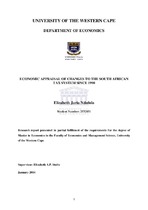| dc.description.abstract | Countries reform their tax systems to improve economic and administrative efficiency, the impact on income distribution and their revenue-raising capacity. Globalisation has also affected the fiscal autonomy of countries and resulted in the reality of tax competition. The South African tax authorities have made significant changes to the tax system in over the past 20 years. The first phase occurred after the publication of the Margo Commission’s report in 1987 and the second phase followed the work done by the Katz Commission since 1996. The objectives of the reforms included the improvement of tax administration and collection, a re-evaluation of the efficiency and equity aspects of the different taxes, the
broadening of the tax base, and most important, to bring the South African tax system in line with changing international tax practise.The main objectives of this study are to give a descriptive overview of the reforms, to investigate the economic rationale behind the reforms and to answer the question of whether the objectives of the reforms were actually achieved. The study fills an important void in the South African literature as it is the first comprehensive overview of the tax reforms since the 1990s.The nature of the study is qualitative and investigative. An overview of the theoretical literature is presented together with some evidence from developing countries. To determine whether the objectives were achieved, descriptive statistics are presented using secondary data from South African
Revenue Service (SARS); National Treasury, the Organisation for Economic Co-operation and Development (OECD) and the South African Reserve Bank (SARB). The main findings are that the establishment of SARS contributed significantly to the administrative efficiency and revenue-raising capacity of the tax system. The taxing of fringe benefits under the personal income tax, the introduction of capital gains tax (CGT) and the residence-based principle contributed to the broadening of the tax base. The decrease of marginal rates of personal income tax (PIT) to be more in line with the rate on company income decreased the possibility of tax arbitrage. The phasing out of the secondary tax on companies together with the decrease of the rate of company income tax (CIT) increased the attractiveness of South Africa for capital-exporting countries. Significant tax relief to middle and lower-income earners over various years improved the equity impact. However it did not improve the position of the really poor, who are not liable for PIT. The increasing contribution of value-added tax (VAT) compensated to the decreasing contribution of trade taxes; the fact that the VAT rate has stayed constant, since 1993 is an indication of the unpopularity of the tax. | en_US |

